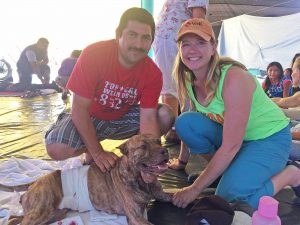More than six months after Hurricane Maria devastated Puerto Rico, Julie Lenoch was spaying a cat by the light of a headlamp. The area’s inconsistent power was out again and the gymnasium – temporarily turned into a veterinary hospital – was dimly, sporadically illuminated by generator-powered floodlights.
Lenoch, a veterinarian and 2014 graduate of the ColoradoSPH at CSU, was several days and dozens of surgeries into a March volunteer trip to Puerto Rico organized by Veterinarios Internacionales Dedicados a Animales Sanos (ViDAS), an organization that brings veterinary volunteers from around the world to areas needing assistance with animal populations. The goal of the work in Puerto Rico, for which Lenoch was one of a team of half a dozen volunteer veterinarians, was to make inroads at controlling animal populations both growing and under increasing stress since the hurricane.
It was work that synthesized veterinary and public health practice, she said, as the health of animal populations can have direct impact on human health.
“Any disruptors of an established system can lead to disease,” she explained. “Hurricane Maria was a huge storm that caused so much destruction and flooding, and even six months later the island is still so damaged. So, things like that, anything that causes people to move, can be drivers of disease.”
Working mostly in the Sabana Grande area, Lenoch and the rest of the ViDAS team partnered with University of Puerto Rico volunteers from the animal science and veterinary tech programs. The spay/neuter clinic was advertised before the ViDAS team’s arrival and pop-up hospital locations secured, so that on the first morning of the clinic “we had 300 people in line by 7 a.m.,” Lenoch said.
Working 14- to 16-hour days, Lenoch performed upwards of 30 spay or neuter operations per day in an intake-surgery-aftercare system that was almost mechanical in its efficiency, she said. Frequently there was no power, so the temporary hospital often grew steamy, but both the animals and their caretakers were patient.
The 10-day clinic in Sabana Grande was a good start, she said, but being on the ground in Puerto Rico made her realize that the island and its people and animals have a long road to recovery.
Linking public health and veterinary medicine
Despite the challenges and seeing first-hand how much Puerto Rico still is coping with, half a year after the hurricane, Lenoch said she always is excited for an opportunity to practice veterinary medicine.
After earning her DVM degree from Colorado State, she practiced veterinary medicine for more than 14 years in Michigan and Colorado, much of that work in trauma care and surgery. Her work led to an interest in the public health  aspect of infectious disease as it relates to veterinary medicine, so she earned first her public health certificate then MPH. She then earned a spot in the CDC’s first class of Health Systems Integration Program fellows.
aspect of infectious disease as it relates to veterinary medicine, so she earned first her public health certificate then MPH. She then earned a spot in the CDC’s first class of Health Systems Integration Program fellows.
The goal of her work there was to “take federal data and value add to health systems at the state level in an actionable way,” she explained. That meant, since she was based at the Wisconsin Department of Health Services, working on a fetal and infant health and death program as well as statewide hospital readiness during the 2015 Ebola outbreak in western Africa.
In 2016, after serving as deputy director of the U.S. Geological Survey’s National Wildlife Health Center in Wisconsin, she became team lead for risk identification with the USDA’s Animal and Plant Health Inspection Service in Fort Collins. This involves disease detection at a global level, following any disease with the potential to affect global trade or food supplies – including foot and mouth disease and African swine fever. It also involves suspicious animal deaths being sent to the Fort Collins office for testing, so there have been days when the mail included a whale or wolf carcass.
Working at the nexus of public health and veterinary medicine, Lenoch said, has opened her eyes to the continuing need for good science, thorough data analysis, practical application and effective communication with those who are or may be impacted.
“The amount of data grows every year, so the need for data analysis grows, too,” she explained. “What I’m doing now is almost like a translator job sometimes, communicating to lawmakers what’s going on with potential global threats to trade and food systems, why it’s important and what we can do about it.”

